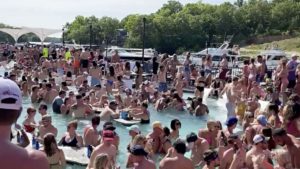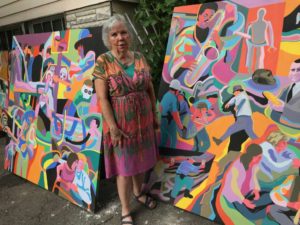 Back in the early 1960’s, I never imagined I’d live to turn 30. The threat of nuclear annihilation loomed over the planet. In high school, I’d been subjected to those ridiculous drills when we crouched under our desks, as if that would somehow save us from Communist bombs raining down and incinerating us. In my junior year at Barnard, I was incredulous when I read about the World’s Fair they were planning for Flushing Meadows in Queens in 1964. Why bother to plan such an extravaganza, when the world would surely be plunged into a nuclear winter with nothing and nobody left alive?
Back in the early 1960’s, I never imagined I’d live to turn 30. The threat of nuclear annihilation loomed over the planet. In high school, I’d been subjected to those ridiculous drills when we crouched under our desks, as if that would somehow save us from Communist bombs raining down and incinerating us. In my junior year at Barnard, I was incredulous when I read about the World’s Fair they were planning for Flushing Meadows in Queens in 1964. Why bother to plan such an extravaganza, when the world would surely be plunged into a nuclear winter with nothing and nobody left alive?
In 1962, the Cuban missile crisis nearly proved me right. For days on end I huddled with my boyfriend near the radio in my  Morningside Heights apartment while Kennedy and Kruschev faced off in deadly games of brinksmanship. The planet survived, but a year later Kennedy was killed by an assassin’s bullet. In early 1964, the Beatles invaded America, and the wild and crazy era of sex, drugs and rock and roll burst upon the scene.
Morningside Heights apartment while Kennedy and Kruschev faced off in deadly games of brinksmanship. The planet survived, but a year later Kennedy was killed by an assassin’s bullet. In early 1964, the Beatles invaded America, and the wild and crazy era of sex, drugs and rock and roll burst upon the scene.
“It’s the end of the world as we know it and I feel fine.” The R.E.M. hit came out in 1987, but it’s a good description of the mood of the late Sixties as I lived it in New York City. Yes, there were assassinations, riots, the war in Vietnam, but AIDS was over a decade away. Sex was free and easy, rock music was at its golden peak of greatness, and, at least for me, life was carefree and joyful.

Today, in the aftermath of the Fourth of July, I’m feeling anything but joyful. Our charlatan clown of a president is getting crazier and scarier by the day. We’re under attack from Covid-19, and the statistics are spiking dangerously higher. The nation has been on lockdown since mid-March. Early on, it seemed the elderly and those with preexisting health conditions were most at risk. There was talk of flattening the curve, and for a time, that seemed to be working, especially in the Northeast, including New York State, where Governor Cuomo had a firm hand on the reins. But as the country has heated up, baking under abnormally high temperatures, people have grown increasingly stir-crazy—especially young people.
 In the Sixties, living in my SoHo loft, painting and partying late into the night, I prided myself on not having a television set. Over fifty years later, I’m hooked on my big flat-screen TV and its dozens of channels, but these days I focus mainly on the news. Especially CNN, although I usually check out the evening news on ABC because David Muir is some fine primetime eye candy.
In the Sixties, living in my SoHo loft, painting and partying late into the night, I prided myself on not having a television set. Over fifty years later, I’m hooked on my big flat-screen TV and its dozens of channels, but these days I focus mainly on the news. Especially CNN, although I usually check out the evening news on ABC because David Muir is some fine primetime eye candy.
I watch the endless footage of young people crowding together outside bars, on beaches and board walks, oblivious to the need for social distancing and masks, partying like there’s no tomorrow. And for many of them, there may not be. The scenes stir memories of the Woodstock Festival, where I showed my paintings in 1969, and of Be-Ins at the sheep meadow in Central Park, but in those days, partying wasn’t contaminated by a possible death sentence. Surely they’re aware of the risks—unless they’re Trump believers buying into a whole different level of craziness. But perhaps they simply don’t care.

When I was young, nuclear annihilation seemed almost inevitable. In the new millennium, it’s still a threat, but only one of many. Catastrophic climate change, economic disasters that pit people and whole societies against each other, murder and mayhem, a pandemic more lethal than Covid-19—there are all sorts of ways the human race can destroy life on this fragile planet. But most of them will happen gradually, over years and decades of destruction like none we’ve ever witnessed before. In fact it’s already happening.
Every day I study the graphs of the pandemic around the world, with the steep climbs to what we can only pray is the peak, but with every passing day, that peak seems more out of reach. My own life has peaked and I’m on the downward slope, but I’m grateful to have lived out my youth in what may turn out to have been the summit of America’s story.
I don’t envy the younger generations who will live out their lives while the country and the planet are in painfully terminal decline. And I can hardly blame them for partying, in the immortal words of Prince, like it’s 1999.
 Here I am with paintings I showed at the Woodstock Festival in 1969 when life seemed a lot sunnier.
Here I am with paintings I showed at the Woodstock Festival in 1969 when life seemed a lot sunnier.
Leave a Reply